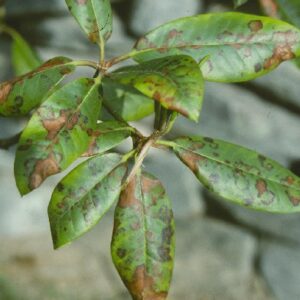Powdery Mildew On Rhododendron

Powdery mildew, a fungal disease caused by various species of fungi, including Erysiphe and Microsphaera, poses a significant threat to the health and beauty of rhododendron plants. Characterized by its powdery, white patches on the leaves, this disease not only mars the aesthetic appeal of these flowering shrubs but also interferes with their ability to photosynthesize, potentially weakening the plant over time. Understanding the causes, symptoms, and management strategies for powdery mildew on rhododendron is crucial for gardeners and horticulturists aiming to maintain the vitality and vigor of these beloved plants.
Causes and Symptoms
The primary cause of powdery mildew on rhododendron is fungal infection. These fungi thrive in environments with high humidity and moderate temperatures, typically between 60°F and 80°F (15°C and 27°C). The infection process begins when spores of the fungus come into contact with the leaves of the rhododendron, often spread by wind, water, or insects. Once infected, the leaves develop white, powdery spots that can coalesce to cover large areas of the leaf surface. This powdery coating is actually the fungal mycelium and spores, which can lead to defoliation if left unchecked, reducing the plant’s capacity for photosynthesis and overall health.
Management and Control
Managing powdery mildew on rhododendron involves a combination of cultural practices, chemical controls, and biological methods aimed at reducing the fungal load and preventing its spread.
Cultural Practices: Perhaps the most effective way to manage powdery mildew is through preventive cultural practices. This includes ensuring good air circulation around the plants by not overcrowding them, avoiding overhead watering which can increase humidity around the leaves, and removing any infected leaves or parts of the plant to prevent the disease from spreading. Additionally, providing the rhododendron with optimal growing conditions, including the right amount of sunlight, water, and nutrients, can help bolster its natural resistance to disease.
Chemical Controls: Fungicides can be an effective tool in controlling powdery mildew. Both systemic and contact fungicides are available, with systemic fungicides being absorbed by the plant and providing protection from within, and contact fungicides acting on the fungus directly on the plant surface. However, the use of chemical fungicides should be approached with caution and as a last resort, due to potential environmental impacts and the development of fungicide-resistant strains of the fungus.
Biological Methods: Biological control methods involve using natural enemies of the fungus to control its growth. This can include introducing beneficial insects or microorganisms that prey on the powdery mildew fungus, thus providing a natural and sustainable means of disease management.
Preventive Measures
Prevention is key in managing powdery mildew on rhododendron. Some preventive measures include:
- Resistant Varieties: Planting rhododendron varieties that have been bred for resistance to powdery mildew can significantly reduce the risk of infection.
- Sanitation: Regularly removing weeds and debris around the plants can help reduce the inoculum potential of the fungus.
- Monitoring: Regular monitoring for the early signs of powdery mildew allows for prompt action, making control measures more effective.
Future Trends and Research
As gardening and horticulture continue to evolve, so does our understanding and approach to managing diseases like powdery mildew. Future trends in disease management are likely to focus on more sustainable and environmentally friendly practices, including the use of biological controls, resistant plant varieties, and advanced diagnostic techniques to detect disease early. Research into the genetic basis of disease resistance in rhododendron and the development of more targeted, less toxic fungicides will also play a crucial role in managing powdery mildew effectively.
Conclusion
Powdery mildew on rhododendron, while a significant concern, can be managed effectively through a combination of good cultural practices, judicious use of chemical controls, and the implementation of biological methods. By understanding the causes and symptoms of the disease and by adopting a proactive approach to prevention and management, gardeners and horticulturists can protect their rhododendron plants from this detrimental fungal disease, ensuring these beautiful flowering shrubs continue to thrive and beautify gardens for years to come.
What are the primary conditions that favor the development of powdery mildew on rhododendron?
+Powdery mildew thrives in environments with high humidity and moderate temperatures, typically between 60°F and 80°F (15°C and 27°C). High humidity, especially in shaded or densely planted areas, and moderate temperatures provide ideal conditions for the development and spread of the disease.
Can powdery mildew on rhododendron be completely eradicated from a garden?
+While it may be challenging to completely eradicate powdery mildew from a garden, effective management strategies can significantly reduce its impact. This includes regular monitoring, prompt removal of infected plant parts, improving air circulation, and possibly the use of fungicides as a last resort. Preventive measures, especially planting disease-resistant varieties and maintaining optimal growing conditions, are crucial in minimizing the occurrence of the disease.
Are there any home remedies or organic treatments for powdery mildew on rhododendron?
+Yes, several home remedies and organic treatments can help manage powdery mildew on rhododendron. These include the use of neem oil, sulfur, and baking soda solutions. Neem oil and sulfur have fungicidal properties and can be used to control the spread of the disease, while baking soda can help raise the pH on the leaf surface, making it less conducive for fungal growth. However, the efficacy of these remedies can vary, and they may not completely eliminate the disease, especially in severe cases.
In conclusion, managing powdery mildew on rhododendron requires a multifaceted approach that incorporates preventive measures, good cultural practices, and, when necessary, the judicious use of chemical or biological controls. By adopting such a comprehensive strategy, gardeners and horticulturists can effectively mitigate the impact of this disease, ensuring the long-term health and beauty of their rhododendron plants.